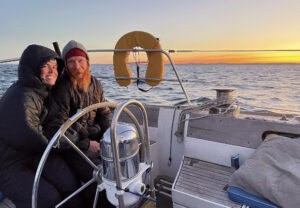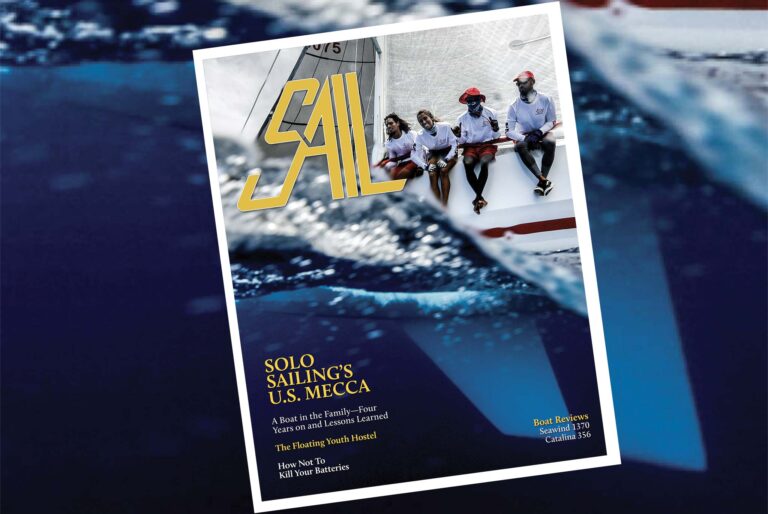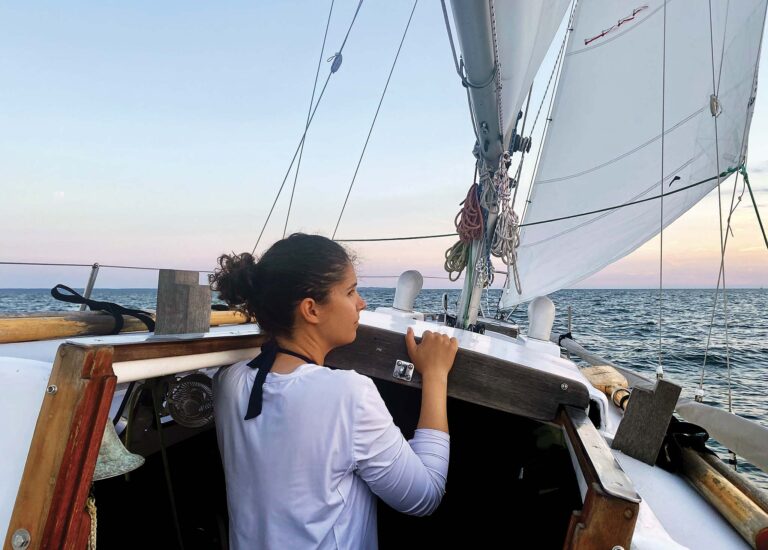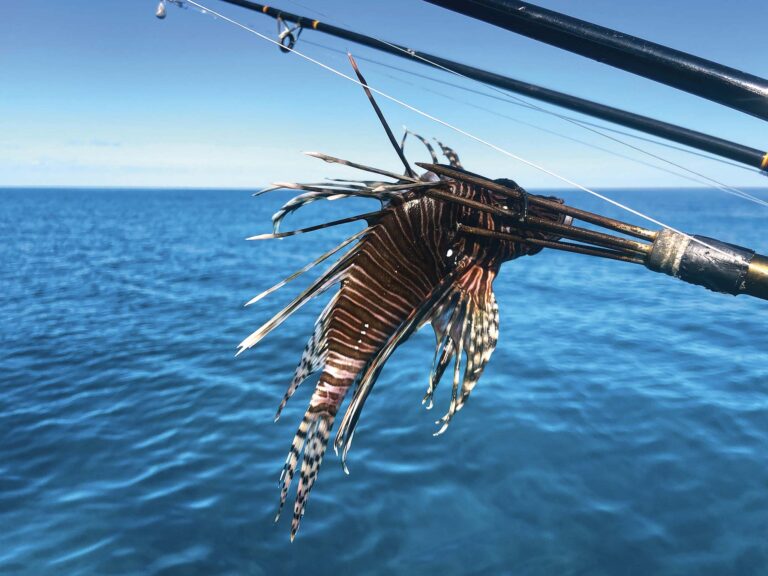
You might say I learned to sail on my family’s 32-foot Pearson Vanguard. But my most memorable lessons came after we dropped anchor, when my father taught me in our Dyer Dhow sailing dinghy. Half a century later, I still remember his precise instructions for an eggshell landing: Aim for the stern of the mothership, and then head up into the wind and come to a stop amidships. Once I’d mastered that and a few other basics, I was allowed—oh, the thrill!—to go sailing by myself.
It was only in my teens, when I was first teaching adults to sail, that I realized how much I’d absorbed from aimlessly tootling around harbors in that little dinghy. Unlike the bigger boat, actions had immediate consequences. Not overhauling a mainsheet in a tack once sent my brother and me—and our groceries, which included ice cream—swimming in a very cold Maine harbor. (For the record, he is almost seven years older, and I was not steering.) A few years later, I soloed too close to the harbor’s edge and the centerboard kicked up, leaving the non-kick-up rudder to stop me short.
Smaller boats allow us to make mistakes without too much damage, which is maybe the fastest and definitely the most memorable way to learn.
Most sailing instruction is oriented toward kids, but it’s a lifetime sport that can be a fun physical and mental challenge at any age. At first glance, bigger boats may seem the safer option; there’s an ergonomic cockpit, lifelines, a cabin…and the water is farther away. But even the simplest cruising boats aren’t ideal learning platforms, and many of the skills needed to safely pilot a larger boat can be learned more easily on a smaller one. By “smaller,” I’m thinking of a dinghy or small keelboat less than 20 feet. By “larger,” I’m imagining a cruising boat big enough for an overnight or weekend adventure.
First, we’ll cover four reasons why that’s true, and then we’ll dig into some specifics.

You don’t need as many crew. With lighter loads and shorter distances between helm and sail handling, fewer people are required to sail a smaller boat. That makes it simpler to schedule your next sailing adventure—though it still should line up with a good weather forecast.
There’s more sensory feedback. Sailing a small boat provides a direct interaction with wind and weather that uses all five senses. Feeling (and smelling) the breeze tells us so much about what the day will bring—dry or damp, light winds or zesty. Our ears can help us assess how happy the boat is: gurgling water sliding by a hull, or slatting sails? Touching the helm or tugging on a line provides instant feedback about balance. And our eyes roam from near to far, always seeking alignment between what we feel/smell/hear/touch and what we see.
Small boats equal small loads. Most cruising boats require mechanical advantage to hoist and trim sails. Once winches are added into the equation, it’s much harder to “feel” a line’s load. The more direct the connection between the sails and your own body, the easier it is to register the effects of each course change and wind shift.
Learning doesn’t take as long. Because the logistics are easier and the feedback is more immediate, learning will be both faster and deeper. It is harder to learn as adults, and perhaps we are more impatient as well, which is why it’s especially worthwhile to make the process as efficient as possible.
Following are a few skills best learned on smaller boats that will directly transfer to larger vessels, and two drills for each.
Rigging and Sailhandling
On a sailboat, we can’t just turn a key and push a throttle forward; first we have to hoist the sails, and then we have to trim them. On our own boats, we also have to rig any lines that are stowed away between adventures.
Small boats have the same basic lines found on bigger boats, with the same (non-intuitive) names. The most important types are halyards (H = Hoist) and sheets, which adjust the sail’s trim. There’s one of each for every sail on the boat.
Drill 1: On a no-wind day or before you leave the dock, identify all of the boat’s lines by name and what they do. E.g., “This is the jib sheet, and it trims the forward sail.”
Drill 2: If the boat is stored on a stable enough dolly or trailer, choose a light-air day to try pulling up the sail(s) on land and then trimming them. Feeling that tug will provide a no-science-needed explanation of why boats move forward. You can also rotate the boat/trailer to sense how wind angle affects sheet load and heel angle; just make sure you don’t “sail” across the boat park into someone else’s pride and joy.
Boathandling
Maneuvering under sail is a combination of steering and sail trim. How to maintain a steady course and achieve the best boat balance can be difficult to understand with so many interconnected variables: wind strength, sea state, boat quirks, heel angle. Small boats make it easier to figure out the cause and effect of each adjustment.
Drill 1: Set a course with the wind at 90 degrees or so, aiming for a point on shore or a buoy. (You can also steer by the compass if there’s one on board, but make sure to keep looking around; don’t get “compass-blind.”) Trim the mainsail in until it stops luffing, and then experiment with over- and under-trimming it through a range of puffs and lulls. How do your adjustments affect the load on the helm and the heel angle? Try the same experiment with the jib if the boat has one; the effects will be different, because the jib is forward of the boat’s center of effort.
Drill 2: Find a small buoy (a mooring or lobster/crab pot) in a low-traffic area and try to stop the boat’s bow right next to it. Unlike approaching a dock (or mothership), there will be no harm done if you overshoot. Remember the basics of eggshell landings: Aim for a spot about a boatlength to leeward, and then head into the wind to slow down. It takes a lot of practice to incorporate all of the variables (wind strength, wave state, boat characteristics) into getting this right, and it’s a key skill on any sized boat. You can also use this drill to pick up any trash you might spot, a plus for the environment!

Piloting and Coastal Navigation
Even a quick afternoon sail requires figuring out where to go and how to get back to the dock on schedule. This is excellent preparation for longer journeys on bigger boats.
Drill 1: Before leaving the dock, plan a route that will get you back ashore at a chosen time. This can be the decision to, say, “sail upwind for 20 minutes before turning downwind,” selecting various buoys to round, or choosing a different harbor as a destination. The goal is to see how your plan works out, because part of fitting sailing into regular life is to reliably get back to the dock when promised.
Drill 2: At any point on your sail, make a guess about how long it will take to get to a specific location. Speeds vary greatly depending on conditions, and even experienced sailors struggle to judge time and distance accurately. If you’re sailing with someone else, consider a friendly wager—perhaps with an extra cookie or beverage as the winner’s reward.
Situational Awareness
There are no traffic lights on the water, and even powerboats don’t always “stay in their lane.” We all need to know the rules of the road and try for consistency and predictability in our own course changes, but sailing in high-traffic areas will be much safer if we also attempt to anticipate the actions of other boaters.
Drill 1: When you see another boat that will cross your course, talk through with your crew (or tell yourself) what you think it’s going to do. Learning to anticipate the actions of other boats (especially if they are moving much faster than you are) will help you develop an instinct for what’s “normal.” Afterward, discuss whether you were right or wrong—and make sure you can answer the most important question of all: why.
Drill 2: Create if-then scenarios ahead of time to minimize the chances of a collision; “IF that boat turns to starboard, THEN we will turn to starboard as well.” Building a set of pre-planned and predictable collision avoidance skills can help reduce reaction time, which is especially important on a crowded summer weekend.
(Bonus tip: Improving situational awareness can also help with land-based navigation.)

Maintenance
Every boat requires a little TLC to remain in tip-top condition, though smaller boats require much less time (and money). That makes them a great starting point for anyone trying to figure out whether they will enjoy doing boat work or would rather hand it off to the pros.
Drill 1: Start a list of boat improvements and try to check at least one off before you go sailing each time. This can be as simple as double checking that shackles are properly moused to avoid unfastening (and subsequently breaking or dumping a sail unexpectedly), replacing worn-out or missing telltales on your sails, and making sure all your shrouds are properly pinned or ring-dinged.
Drill 2: If you are sailing on someone else’s boat, tactfully identify something that looks like it needs maintenance—and then offer to help.
Next Step: Learn Large
Not every lesson from dinghy sailing will translate; unlike that childhood capsize, boats with keels will just heel a little extra if the mainsheet catches in a tack. And many specialized cruising skills just can’t be duplicated on a smaller, simpler, boat (or are quite boat-specific). A few examples include anchoring, operating navigational equipment and other systems, safe winch use, and wheel steering. To make that next step, it may be helpful to invite a more experienced sailor (or even hire an instructor) to come out and help you learn.
Even after a half-century of sailing adventures on boats big and small, I still breathe a sigh of relief when I first trim in the sails and accelerate. On any sized vessel, there’s nothing like knowing I can go almost anywhere my heart desires—and then return on schedule to make an eggshell landing. Learning may be harder as an adult, but the joys of independent sailing are ageless—and definitely easier to learn when you start small.

August/September 2024









